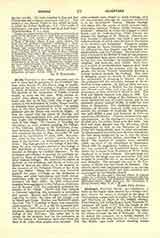

Alcantara, MILITARY ORDER OF.—Alcantara, a town on the Tagus (here crossed by a bridge—cantara, whence the name), is situated in the plain of Estremadura, a great field of conflict for the Moslems and Christians of Spain in the twelfth century. First taken in 1167 by the King of Leon, Fernando II, Alcantara fell again (1172) into the hands of the fierce Jussuf, the third of the African Almohades; nor was it recovered until 1214, when it was taken by Alonzo of Leon, the son of Fernando. In order to defend this conquest, on a border exposed to many assaults, the king resorted to military orders. The Middle Ages knew neither standing armies nor garrisons, a deficiency that the military orders supplied, combining as they did military training with monastic stability. Alcantara was first committed (1214) to the care of the Castilian Knights of Calatrava, who had lately given many proofs of their gallantry in the famous battle of Las Navas de Tolosas against the Almohades (1212). Alonzo of Leon wished to found at Alcantara a special branch of this celebrated order for his realm. But four years later these Knights felt that the post was too far from their Castilian quarters. They gave up the scheme and transferred the castle, with the permission of the king, to a peculiar Leonese order still in a formative stage, known as “Knights of St. Julian de Pereiro”. Their genesis is obscure, but according to a somewhat questionable tradition, St. Julian de Pereiro was a hermit of the country of Salamanca, where by his counsel, some knights built a castle on the river Tagus to oppose the Moslems. They are mentioned in 1176, in a grant of King Fernando of Leon, but without allusion to their military character. They are first acknowledged as a military order by a privilege of Pope Celestine III in 1197. Through their compact with the Knights of Calatrava, they accepted the Cistercian rule and costume, a white mantle with the scarlet overcross, and they submitted to the right of inspection and correction from the Master of Calatrava. This union did not last long. The Knights of Alcantara, under their new name, acquired many castles and estates, for the most part at the expense of the Moslems. They amassed great wealth from booty during the war and from pious donations. It was a turning point in their career. However, ambitions and dissensions increased among them. The post of grand master became the aim of rival aspirants. They employed against one another swords which had been vowed only to warfare against the infidels. In 1318, the castle of Alcantara presented the lamentable spectacle of the Grand Master, Ruy Vaz, besieged by his own Knights, sustained in this by the Grand Master of Calatrava. This rent in their body showed no less than three grand masters in contention, supported severally by the Knights, by the Cistercians, and by the king. Such instances show sufficiently to what a pass the monastic spirit had come. All that can be said in extenuation of such a scandal is that military orders lost the chief object of their vocation when the Moors were driven from their last foothold in Spain. Some authors assign as causes of their disintegration the decimation of the cloisters by the Black Death in the fourteenth century, and the laxity which recruited them from the most poorly qualified subjects. Lastly, there was the revolution in warfare, when the growth of modern artillery and infantry overpowered the armed cavalry of feudal times, the orders still holding to their obsolete mode of fighting. The orders, nevertheless, by their wealth and numerous vassals, remained a tremendous power in the kingdom, and before long were involved deeply in political agitations. During the fatal schism between Peter the Cruel and his brother, Henry the Bastard, which divided half Europe, the Knights of Alcantara were also split into two factions which warred upon each other.
The kings, on their side, did not fail to take an active part in the election of the grand master, who could bring such valuable support to the royal authority. In 1409, the regent of Castile succeded in having his son, Sancho, a boy of eight years, made Grand Master of Alcantara. These intrigues went on till 1492, when Pope Alexander VI invested the Catholic King, Ferdinand of Aragon, with the grand mastership of Alcantara for life. Adrian VI went farther, in favor of his pupil, Charles V, for in 1522 he bestowed the three masterships of Spain upon the Crown, even permitting their inheritance through the female line. The Knights of Alcantara were released from the vow of celibacy by the Holy See in 1540, and the ties of common life were sundered. The order was reduced to a system of endowments at the disposal of the king, of which he availed himself to reward his nobles. There were no less than thirty-seven “Commanderies”, with fifty-three castles or villages. Under the French domination the revenues of Alcantara were confiscated, in 1808, and they were only partly given back in 1814, after the restoration of Ferdinand VII. They disappeared finally during the subsequent Spanish revolutions, and since 1875 the Order of Alcantara is only a personal decoration, conferred by the king for military services. See Military Orders.
CH. MOELLER

